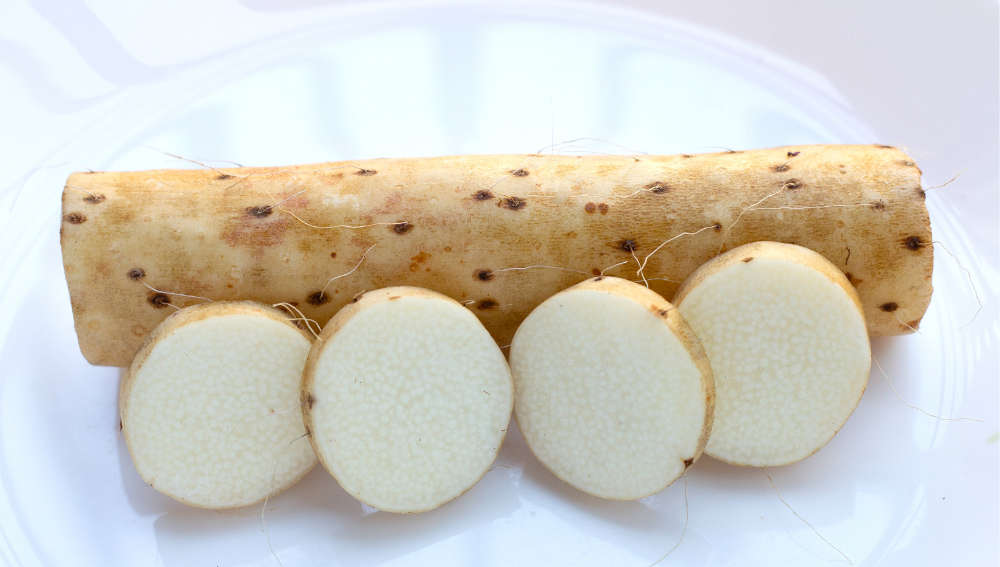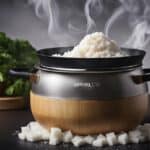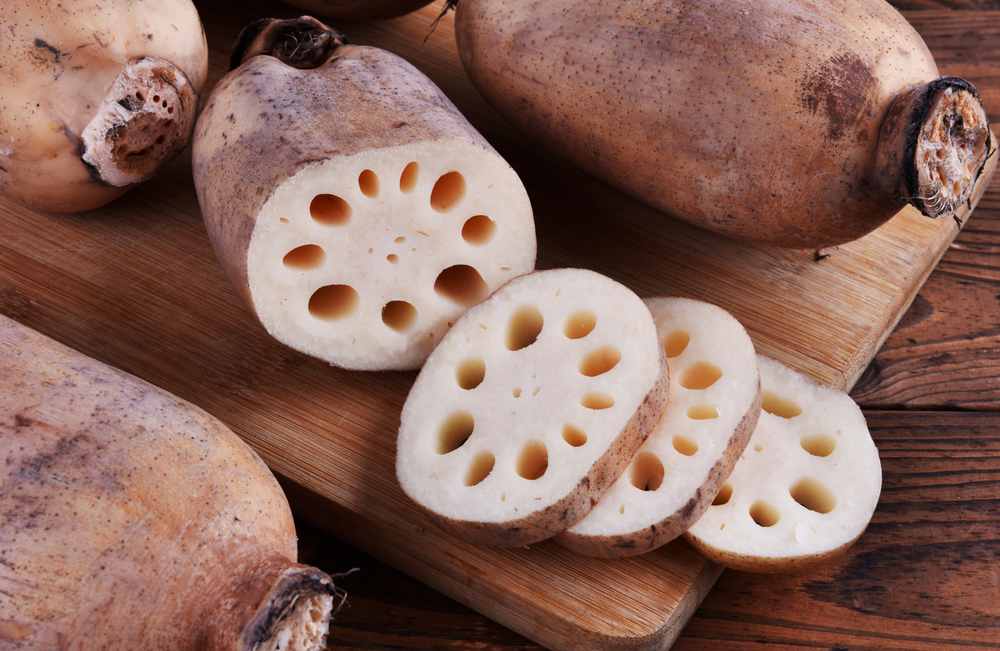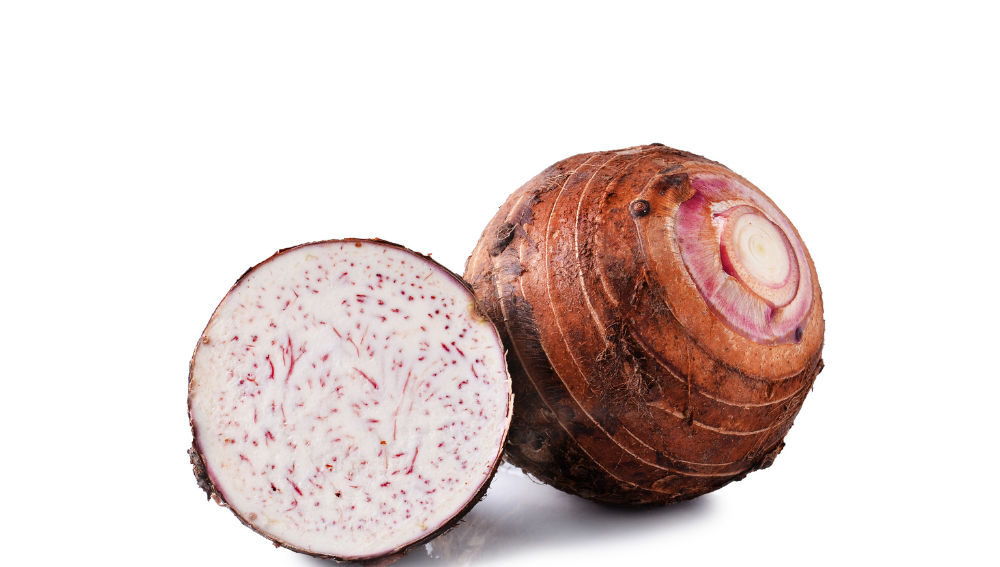Nagaimo, also known as Chinese yam or Dioscorea opposita, is a tuberous root native to East Asia. Popular in Japan and China, it is often consumed after grating to form a glutinous, slime-like texture.
Its unique consistency makes it a versatile ingredient in dishes like Okonomiyaki, Tororo, and more. However, nagaimo may not be readily available in some locations, or individuals may have dietary restrictions or allergies, prompting the need for a suitable substitute.
Selecting an appropriate substitute for nagaimo requires understanding its role in various dishes, texture, and flavor profile.
While it can be challenging to find another ingredient that truly replicates the specific characteristics of nagaimo, several alternatives can still provide similar benefits when incorporated into recipes.
An ideal substitute should mimic the function, taste, and nutritional value of nagaimo to ensure success in preparing a wide range of dishes.
Key Takeaways
- Understanding the unique properties and role of nagaimo in Japanese cuisine is crucial for identifying substitutes.
- Choose alternative ingredients based on their ability to replicate nagaimo’s flavor, texture, and nutritional benefits.
- Successfully incorporating substitutes requires consideration of their impact on vegan recipes and adaptations to their usage.
Understanding Nagaimo

Nagaimo, also known as Japanese yam or yamaimo, is a popular ingredient in Japanese cuisine. It is a type of mountain yam that has a slimy texture when raw, which contributes to its unique culinary applications.
This perennial tuber, originating in China, is often grated and used as a binding or thickening agent in various dishes.
There are several species of yams, with nagaimo and Chinese yam being the most common varieties found in Japanese food. The term “nagaimo” is derived from the elongated shape of the tuber, which can grow up to 1 meter in length.
Both nagaimo and Chinese yam share similar properties and can be used interchangeably in recipes.
One of the key characteristics of nagaimo is its sliminess, caused by the presence of mucilage, a natural gel-like substance found in certain plants. This sliminess serves a purpose in cooking, creating a smooth and creamy consistency in dishes.
In addition, when grated, it produces a voluminous foam that can be used to achieve light and airy textures in culinary creations.
Nagaimo’s versatility makes it a valued ingredient in Japanese cooking. It can be consumed in various forms, such as raw, grated, sliced, boiled, or fried.
Common dishes that feature nagaimo include okonomiyaki (Japanese savory pancake), tororo (grated yam served over rice), and nabe (hot pot).
In summary, nagaimo’s unique slimy texture and versatility set it apart from other yam varieties and make it a popular choice in Japanese cuisine.
While there are substitutes available, understanding its distinct features and the role it plays in dishes can enhance the culinary experience.
The Role of Nagaimo in Japanese Cuisine
Nagaimo, also known as Japanese mountain yam, is a versatile ingredient that plays a significant role in Japanese cuisine.
This starchy tuber is highly valued for its unique texture and nutritional benefits. It is often grated into a sticky paste, which is then used as a thickening agent in various dishes.
One of the most popular dishes that feature nagaimo is Okonomiyaki, a savory Japanese pancake. This dish typically includes a batter made from egg, flour, water, and grated nagaimo.
The addition of nagaimo to the batter provides a light, fluffy texture to the pancakes, enhancing their overall taste and mouthfeel.
In addition, nagaimo is commonly used as a binder in the preparation of other Japanese dishes. Its sticky consistency makes it an excellent substitute for eggs in recipes that require a binding agent.
When mixed with flour and water, the grated nagaimo forms a smooth, cohesive batter that can be easily spread and cooked.
Besides its culinary uses, nagaimo is also known for its health benefits. It is a good source of vitamins, minerals, and dietary fiber, contributing to its increasing popularity in health-conscious diets.
Its neutral flavor makes it easy to incorporate into a variety of dishes without altering their taste profiles too drastically.
In summary, nagaimo is a versatile and valuable ingredient in Japanese cuisine, often playing a supporting role to enhance texture and binding capabilities in dishes like Okonomiyaki.
Its unique qualities and nutritional benefits make it a highly sought-after component in many traditional and modern recipes.
Substitutes for Nagaimo

Nagaimo, a type of yam known for its unique slimy texture and numerous health benefits, might not always be available or preferred by some individuals.
Thankfully, there are several alternatives that can still provide similar culinary experiences.
Potatoes can serve as a reliable substitute for Nagaimo due to their starchy content and versatility in cooking. Though potatoes might not have the same slimy consistency as Nagaimo, they can still add a creamy and smooth texture to dishes.
Mashed or grated potatoes can be used in recipes that call for Nagaimo, offering a satisfying and accessible alternative.
Radish is another suitable replacement for Nagaimo. Daikon radish, in particular, shares a similar crunchy texture and mild flavor with Nagaimo. Grated or finely chopped daikon can mimic the sliminess of Nagaimo, making it an excellent alternative.
While radishes may vary in taste, they are widely available, and experimenting with different varieties can help find the best match for a specific dish.
Incorporating yam flour into recipes can also replicate the unique qualities of Nagaimo. Yam flour is made from dried and ground yam roots and can be mixed with water to create a paste resembling the consistency of grated Nagaimo.
The paste can then be used in a recipe, providing a similar texture and taste. Additionally, yam flour is gluten-free, making it compatible with various dietary needs and preferences.
In summary, when Nagaimo is not an option, potatoes, radishes, and yam flour are viable alternatives that can closely approximate the specific qualities of this unique yam.
Each substitute offers its own advantages and flavors, allowing for experimentation and the opportunity to discover new favorites in the kitchen.
Substitute Selection Based on Flavor and Texture
When looking for a suitable substitute for nagaimo, two essential factors to consider are flavor and texture. Nagaimo is known for its unique slimy texture and mild taste, which contribute to the overall appeal of many traditional East Asian dishes.
Therefore, it is essential to find alternatives that can closely mimic these characteristics without compromising the dish’s authenticity.
One viable substitute to consider is grated mountain yam, which shares a similar slimy texture with nagaimo. With its neutral flavor profile, grated mountain yam can be easily incorporated into dishes without altering the taste significantly.
Another suitable replacement is jicama, a root vegetable with a crunchy texture similar to nagaimo. Although not as slimy as nagaimo, jicama can contribute a satisfying bite to dishes when prepared correctly.
The flavor of jicama is mild and slightly sweet, making it a versatile ingredient that can blend well with various recipes. To further enhance its taste, consider adding some soy sauce to complement the dish’s flavors.
Alternatively, using cabbage can be a practical solution when seeking a nagaimo substitute based on texture and flavor. Cabbage has a more robust flavor compared to nagaimo, but it can still provide that desired crunchy texture when cooked or eaten raw.
When selecting a nagaimo substitute, it is crucial to remember that the chosen ingredient should not only mimic the texture but also respect the dish’s original flavors.
Whichever substitute you opt for, grated mountain yam, jicama, or cabbage, it is essential to ensure that these options effectively preserve the integrity of the dish while providing an enjoyable culinary experience.
How to Incorporate Substitutes
Finding the perfect substitute for nagaimo in your recipes can be a challenge, but with a bit of creativity and knowledge of alternative ingredients, it’s possible to achieve delicious results.
There are several options that you may consider depending on the dish and how you’d like to use the substitute.
Potato starch can be an excellent substitute for nagaimo, particularly when added to a frying pan to create a crispy coating for various dishes. To use potato starch in place of nagaimo, simply coat your ingredients evenly in the starch before frying them.
This can be ideal for recipes that require a smooth texture and flavor, while providing a similar binding and thickening effect as nagaimo.
Another option for a nagaimo substitute is grated jicama. Jicama can be used in many recipes that call for grated nagaimo, as it has a neutral taste and crunchy texture.
To incorporate jicama into a recipe, simply peel and grate it as you would nagaimo, then mix it with other ingredients to create the desired dish.
Adding the appropriate seasoning will enhance the taste and give your meal the flavor it needs.
In certain recipes, Japanese yam can also serve as an alternative to nagaimo. If you don’t have nagaimo available, you can simply substitute it with grated Japanese yam.
They have similar characteristics in terms of texture and binding properties, making them ideal for dishes that require a gluey or slippery texture.
Mucilage-rich seeds, such as chia seeds or flaxseeds, can be another option when trying to find a substitute for nagaimo. These seeds can be used as a thickening and binding agents in various dishes, especially when making batters or dough.
To use these seeds as a substitute, grind them into a fine powder and then add water to create a gel-like consistency. The mixture can then be incorporated into your recipe according to the directions.
By considering these various substitutes and following the provided usage guidelines, you can successfully incorporate them into your recipes to achieve an experience similar to that of using nagaimo.
Each substitute has specific characteristics that make them ideal for certain types of dishes, so take care to choose the most appropriate one for your particular recipe.
Nutritional Comparison of Substitutes

Nagaimo, also known as Chinese yam or Dioscorea opposita, is popular for its versatile texture and nutritional benefits, but finding a suitable substitute can be daunting.
In this section, we will discuss the nutritional aspects of some common substitutes for nagaimo.
Potato: As a readily available root vegetable, potatoes are a common substitute for nagaimo. They are high in carbohydrates and potassium, providing a good source of energy.
However, their protein and fiber content is relatively low, and they contain negligible fat. Moreover, potatoes have higher calories than nagaimo, but no cholesterol.
Taro: Another root vegetable, taro is closely similar to nagaimo in terms of texture. Nutrient-wise, taro has a higher fiber content compared to nagaimo, promoting digestive health.
Additionally, taro contains a moderate amount of carbohydrates and potassium, but lower levels of protein and fat. Taro also lacks cholesterol.
Cassava: Cassava, or yuca, is a starchy root that can be substituted for nagaimo. Its nutritional composition includes high levels of carbohydrates while being rich in potassium.
Cassava has an average amount of fiber, and negligible amounts of fat and protein. Furthermore, cassava is cholesterol-free.
Jicama: Jicama is a Mexican root vegetable with a similar texture to nagaimo. Nutritionally, it is high in potassium and contains a decent amount of fiber.
However, its carbohydrate content is considerably low, making it a low-calorie option. Jicama also has trace amounts of protein and fat, and contains no cholesterol.
To sum up, all four substitutes provide distinct nutritional differences compared to nagaimo. Potatoes and cassava are richer in carbohydrates, while taro and jicama offer slightly higher fiber content.
Protein, fat, and cholesterol levels tend to be low across these substitutes, with potassium being a consistent presence in each. Ultimately, the substitute chosen can significantly impact diet and nutritional goals.
Incorporating Substitutes in Vegan Recipes

Finding the perfect substitute for nagaimo in vegan recipes can be challenging, but there are several options to consider. One popular choice in vegan cooking is to use grated daikon.
It’s a versatile vegetable that features a similar texture and moisture content to shredded nagaimo, making it a suitable alternative.
Another option is to use grated mountain yam, also known as “yamaimo.” Like nagaimo, it has a slimy texture and is rich in nutrients, making it an excellent choice for vegan dishes.
For a more nutritious alternative, some people opt for using kombu or kelp as a substitute. These ingredients, which are both high in fiber and have a rich umami flavor, work well as a base for soups, stews, and sauces.
To enhance the depth of flavor in vegan dishes like okonomiyaki, the use of condiments such as nori and aonori is essential.
These ingredients can be sprinkled on top of the dish or incorporated into the batter. Their unique flavor profile adds a layer of complexity and authenticity to vegan recipes.
It’s also important to pay attention to the oil used in cooking. Sesame seed oil is a fantastic option for vegan recipes due to its distinct, nutty flavor and heart-healthy properties.
Its high smoke point makes it ideal for frying or sautéing vegetables, tofu, or tempeh.
Okonomi sauce, a quintessential Japanese condiment, can be made vegan by using ingredients such as soy sauce, agave syrup, and tomato paste.
This sauce lends a rich, savory, and slightly sweet taste to dishes, complementing the flavors of the chosen nagaimo substitute.
While experimenting with substitutes in vegan recipes, don’t be afraid to try different combinations of seasonings, vegetables, and sauces.
Maintaining the balance of flavors and textures with the selected substitute will ensure that your dish remains delicious and satisfying.
With these substitutions, creating authentic and healthful vegan meals becomes effortless and enjoyable.
Additional Tips for Using Nagaimo Substitutes
When using nagaimo substitutes in your dishes, it is essential to consider their individual characteristics and how they interact with other ingredients.
This approach ensures that the flavors and textures in your meals remain balanced and enjoyable.
Rice, for example, is a common ingredient in many dishes that may also include nagaimo.
When substituting with another ingredient like taro or potato, be mindful of the starchiness and adjust cooking times accordingly. This will help maintain the desired texture of the rice in your dish.
In dishes that call for a combination of sugar and nagaimo, consider experimenting with different sweeteners to achieve the right balance.
A hint of cinnamon may also be added in small quantities to complement the flavors and enhance the overall taste of the meal.
Dashi, a Japanese broth made from kombu (kelp) and sometimes fish or meat, can be an essential component in recipes that include nagaimo.
When using an alternative like daikon radish or jicama, incorporating dashi can help retain that authentic Japanese flavor.
Be attentive to the thickness and consistency of the broth when using these substitutes, as adjustments may be required to achieve the right balance.
In meals featuring meat or fish with nagaimo, textures and flavors play a crucial role. When substituting with another ingredient, such as a yam or potato, play with seasonings and marinades to bring out the best taste in your protein.
This will ensure that the substitute complements your dish without overpowering it.
Resist the temptation to introduce too many substitutes at once, as this might create an imbalance of flavors. Instead, try experimenting with one or two alternatives before venturing further.
By doing so, you can be confident that your dish stays true to its original taste and texture while benefiting from the unique properties of nagaimo substitutes.
Frequently Asked Questions
What can replace nagaimo in recipes?
There are several alternatives for replacing nagaimo in recipes. Some common substitutes include grated potato, daikon radish, or turnip.
These root vegetables can provide a similar texture and consistency as nagaimo when grated or pureed.
How can I make okonomiyaki without nagaimo?
To make okonomiyaki without nagaimo, you can use grated potato or daikon radish as a substitute. Simply replace equal amounts of either ingredient for the nagaimo called for in the recipe.
The final dish may have a slightly different texture, but it will still be delicious.
Which root vegetable is a good substitute for nagaimo?
The most suitable root vegetable substitutes for nagaimo are grated potato and daikon radish. Both of these alternatives can mimic the texture and consistency of nagaimo when grated or pureed.
Turnip is another option, but its flavor may not be an ideal match for all recipes.
Are there any non-root alternatives to nagaimo?
Yes, there are non-root alternatives to nagaimo. Some options include pureed konjac root (konnyaku), cauliflower mash, or cornstarch mixed with water.
While these substitutes may not replicate the exact texture of nagaimo, they can be suitable alternatives in certain recipes.
What can I use instead of Yamaimo or Chinese yams?
In place of yamaimo or Chinese yams, you can use grated potato, daikon radish, or turnip. These root vegetables offer a similar texture and consistency to yamaimo and Chinese yams when grated or pureed, making them suitable replacements for most recipes.
How do the differences between Yamaimo and nagaimo affect substitutions?
Yamaimo and nagaimo are closely related root vegetables and both have a slimy texture when grated or pureed. Their differences are minor, with yamaimo typically being larger and more irregular in shape compared to nagaimo.
Substitutions for either root vegetable can generally be used interchangeably, as the texture and consistency of their substitutes will be similar.







